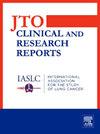Next-Generation Sequencing Analysis on Image-Guided Biopsy Samples in Early-Stage Lung Cancer: Feasibility Study and Comparison With Surgical Samples
IF 3.5
Q2 ONCOLOGY
引用次数: 0
Abstract
Introduction
Limited information exists on next-generation sequencing (NGS) success for lung tumors of 30 mm or less. We aimed to compare NGS success rates across biopsy techniques for these tumors, assess DNA sequencing quality, and verify reliability against surgical resection results.
Methods
We used data from the Initiative for Early Lung Cancer Research on Treatment study, including patients with lung tumors measuring 30 mm or less who had surgery and NGS on biopsies since 2016. We collected data on biopsy type, nodule characteristics, complications, sequencing feasibility, clinical actionable variants, surgery type, and TNM classification. We compared NGS feasibility and quality between biopsy methods and, for those with NGS on surgical samples, compared feasibility, quality, and detection of actionable variants.
Results
Among the 654 participants with lung tumors of 30 mm or less who underwent surgery, 70 had NGS on prior biopsies. The median age was 68.5; 51.4% were male individuals, and 75.7% were smokers. The mean diameter of biopsied nodules was 17.7 mm, with 67.1% fine-needle aspiration, 17.1% computed tomography–guided transthoracic core needle biopsies, and 17.1% endobronchial ultrasound–guided transbronchial needle aspiration. DNA sequencing was feasible in 97.1% of biopsy samples; 2.9% had low tumor cellularity. Coverage depth was achieved in 89.7% of biopsies. RNA sequencing was successful in 66.2% of biopsies, especially in core needle biopsies. Actionable alterations were found in 41.4% of patients. Among the participants, 30% had NGS on surgical samples. RNA sequencing was more feasible on surgical samples (95.2% versus 42.9% for biopsies). NGS on surgical samples matched biopsy results in 90% of patients, with 10% showing additional alterations.
Conclusion
DNA sequencing succeeded in 97.1% of biopsies of nodules 30 mm or less, whereas RNA sequencing feasibility was lower. NGS on biopsy samples is generally reliable but requires careful review.


早期肺癌影像引导活检样本的新一代测序分析:可行性研究及与手术样本的比较。
关于下一代测序(NGS)在30mm或更小的肺肿瘤中的成功信息有限。我们的目的是比较不同活检技术对这些肿瘤的NGS成功率,评估DNA测序质量,并验证手术切除结果的可靠性。方法:我们使用来自早期肺癌治疗研究倡议的数据,包括2016年以来接受手术和活检的30 mm或以下肺肿瘤患者。我们收集了活检类型、结节特征、并发症、测序可行性、临床可操作变异、手术类型和TNM分类的数据。我们比较了不同活检方法间NGS的可行性和质量,对于手术样本采用NGS的患者,比较了可行性、质量和可操作变异的检测。结果:在654名接受手术的30毫米或更小的肺肿瘤患者中,70人在先前的活检中有NGS。中位年龄为68.5岁;51.4%为男性,75.7%为吸烟者。活检结节平均直径为17.7 mm,其中细针穿刺67.1%,计算机断层引导下经胸核心穿刺17.1%,超声引导下经支气管穿刺17.1%。97.1%的活检样本DNA测序是可行的;2.9%肿瘤细胞密度低。89.7%的活检达到了覆盖深度。RNA测序在66.2%的活检中成功,特别是在核心针活检中。41.4%的患者发现了可操作的改变。在参与者中,30%的手术样本有NGS。RNA测序在手术样本中更为可行(95.2%对42.9%的活检)。手术样本的NGS与90%的患者的活检结果相匹配,10%的患者显示额外的改变。结论:对30mm及以下的结节,DNA测序成功率为97.1%,而RNA测序的成功率较低。活检样本的NGS通常是可靠的,但需要仔细审查。
本文章由计算机程序翻译,如有差异,请以英文原文为准。
求助全文
约1分钟内获得全文
求助全文
来源期刊

JTO Clinical and Research Reports
Medicine-Oncology
CiteScore
4.20
自引率
0.00%
发文量
145
审稿时长
19 weeks
 求助内容:
求助内容: 应助结果提醒方式:
应助结果提醒方式:


